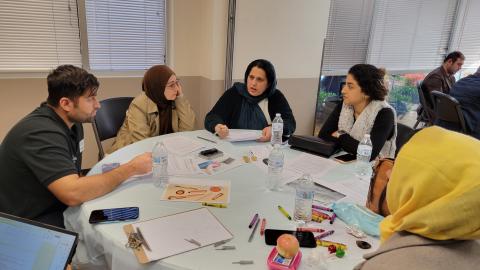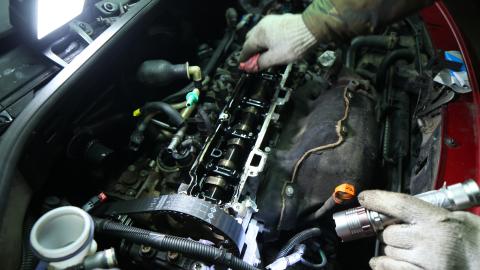Could studying how zebrafish swim help uncover a cure for autism? Yijie Geng thinks so.
A new assistant professor in the UW Department of Environmental & Occupational Health Sciences (DEOHS), Geng is on the hunt for chemicals in the environment that increase people’s risk for autism. About 40% of autism risk comes from environmental factors, scientists have shown.
In Geng’s Fishbook assay, normal zebrafish in a test channel usually swim toward their fellow fish (visible through a glass pane at top). Fish treated with chemicals that inhibit the enzyme Top2 tend to wander around the channel, like the fish in the fifth channel from left. Source: Yijie Geng/ScienceDirect.
But wading through the myriad of chemicals in our environment to find which ones may be linked with autism is a challenge worthy of Rumpelstiltskin. That’s where the zebrafish come in.
Like humans, zebrafish are highly social creatures; they tend to swim toward one another. Their small size and aquatic environment also make it easy to expose them to different chemicals and monitor their behavior for signs that mimic characteristics of autism, such as reduced social interest.
Geng developed a first-of-its-kind method, which he dubbed “Fishbook,” that can screen up to a thousand zebrafish per day. With the method, he identified a group of chemicals that disrupts the creatures’ usual curious behavior about their fellow fish in a manner similar to autism.
“It knocks out their social preference,” he said. “They are otherwise completely normal, but they just start to wander around the channel.”
Autism risk chemicals
The group of chemicals Geng has identified include some notorious toxic environmental pollutants: polychlorinated biphenyls (PCBs), bisphenol A (BPA) and the pesticide chlorpyrifos, among others. They inhibit an enzyme found in all vertebrates called topoisomerase 2 (Top2).
The enzyme is present in all our cells and has a critical job: untangling DNA strands that tend to knot up in the tight confines of the cell like necklaces in a jewelry box. Experiments in developing zebrafish show that inhibiting Top2 specifically inhibits genes related to autism. Previous studies in human and mouse cells have shown similar results.
“It seems to be highly selective toward regulating the expression of autism-related genes,” Geng said, “which explains the high specificity of outcome when you inhibit the enzyme” in zebrafish.
“Finding molecular pathways that regulate social behavior related to autism gives us hope that we can develop therapeutic tools to target these pathways and treat autism.”
- Yijie Geng
A path toward an autism drug?
Learn more about Dr. Geng's work on his website
“One potential thing that excites me is to find a cure for autism,” Geng said. “Right now, there are only behavioral modification methods to help patients cope with the disease.”
Geng’s research has uncovered a complex biochemical pathway that holds promise for developing autism therapeutics. He and his team found that Top2 inhibitors trigger an epigenetic regulatory pathway—or one that alters the function of a gene without altering its DNA. This pathway leads to the inhibition of autism-related genes.
It means that when a human fetus or a zebrafish embryo is exposed to a Top2 inhibitor, autism-related genes remain inhibited even if the Top2-inhibiting chemical is removed.
But Geng’s team has discovered a small molecule that can reverse this epigenetic pathway and restore the activity of the genes and normal social behavior in zebrafish. He is now testing the strategy in mice.
“It's quite rare to see that kind of rescue,” Geng said. “I think this might be one of the few actual therapeutic approaches that we can potentially apply to treat autism patients, or at least a subtype of autism patients.”
Building Fishbook
 Geng’s Fishbook assay can screen a thousand fish a day; in contrast, researchers studying social behavior in mice can screen only about 30 mice a day.
Geng’s Fishbook assay can screen a thousand fish a day; in contrast, researchers studying social behavior in mice can screen only about 30 mice a day.
To build the high-throughput setup, Geng and his research team first used 3D printing to create a series of small channels for the zebrafish to swim in—44 of them fill space about the size of a piece of printer paper.
They image the fish’s behavior in these channels using a special, four-foot-tall lens that is normally used in manufacturing to check the quality of parts made for large equipment. It doesn’t distort images captured while the fish swim in the water because it only takes in light perpendicular to the lens.
“We’re the only ones in the world who have this equipment” for high-throughput screening, he said.
Geng also plans to create a set of zebrafish lines to study the interplay of genetics and the environment in disease. The new project was recently funded by the Interdisciplinary Center for Exposures, Diseases, Genomics and Environment (EDGE), part of DEOHS.
“Once established, the platform we are developing has the potential to substantially improve our understanding of why different individuals respond differently to the same environmental exposure," Geng said.
Settling in at the UW
A self-described “city boy,” Geng was excited to arrive in Seattle last December, which he particularly appreciates for its vibrant Asian culture and clean air.
He is now in the process of renovating his zebrafish lab in the Roosevelt One building, which he inherited from Professor Emeritus Evan Gallagher.
He’s looking forward to having a new PhD student and master’s student join him and his research technicians in the lab this fall, and to recruiting more students in the future.
In winter quarter 2024, he’ll be teaching the course Environmental Poisons and Public Health with Professor Elaine Faustman.




